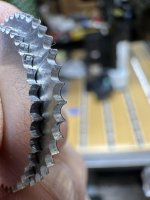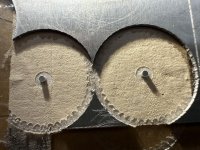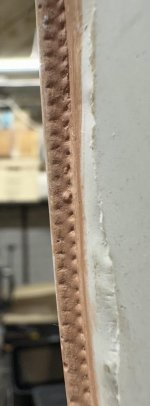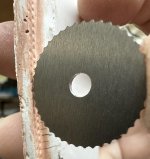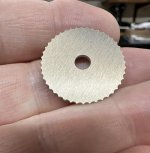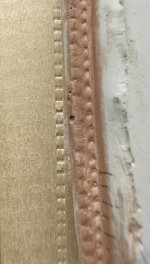Michael Kellough
Member
Making some small gears for a professional gilder.
He has to reproduce the decorative dot dash pattern on an antique frame.
I’ll replace the wheels in a window screen spline installation tool with these wheels after a little more modification.
[attachimg=1]
Diameter is one inch. Tooth pitch is .072. Aluminum is .043” thick.
Used an O flute 1/16” bit to rough it out and finished with a 2 or 3 flute 1/32” bit to get into the valleys.
If the aluminum isn’t durable enough I’ll redo it in brass.
In this pic the rougher result on the left was done with a used 2 flute bit and the better example on the right with a fresh 3 flute bit. Spindle speed 6 and 5fpm feed. I brush on a waxy lube every 2 laps. After cutting out a bunch of the gears I realized that the waxy stuff kept the little chips from going very far and I could leave the vac turned off and just turn it on after two laps to pull the debris out of the groove, and then brush more lube in.
[attachimg=2]
The double stick tape used by the Shaper people works well. The little bit of aluminum is standing after a ring was cut around it.
I included this photo to show how the automatic Z touch can get different results with different bits. The O flute bit ended up cutting deeper than the 3 flute bit at the same depth setting. I actually had to cut .002” deeper with the smaller bit just to get all the way through the aluminum.
He has to reproduce the decorative dot dash pattern on an antique frame.
I’ll replace the wheels in a window screen spline installation tool with these wheels after a little more modification.
[attachimg=1]
Diameter is one inch. Tooth pitch is .072. Aluminum is .043” thick.
Used an O flute 1/16” bit to rough it out and finished with a 2 or 3 flute 1/32” bit to get into the valleys.
If the aluminum isn’t durable enough I’ll redo it in brass.
In this pic the rougher result on the left was done with a used 2 flute bit and the better example on the right with a fresh 3 flute bit. Spindle speed 6 and 5fpm feed. I brush on a waxy lube every 2 laps. After cutting out a bunch of the gears I realized that the waxy stuff kept the little chips from going very far and I could leave the vac turned off and just turn it on after two laps to pull the debris out of the groove, and then brush more lube in.
[attachimg=2]
The double stick tape used by the Shaper people works well. The little bit of aluminum is standing after a ring was cut around it.
I included this photo to show how the automatic Z touch can get different results with different bits. The O flute bit ended up cutting deeper than the 3 flute bit at the same depth setting. I actually had to cut .002” deeper with the smaller bit just to get all the way through the aluminum.

